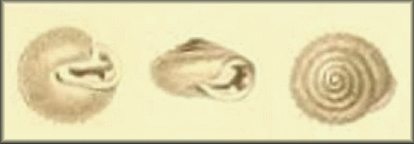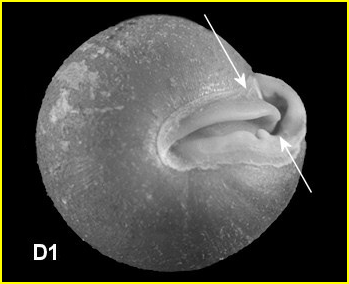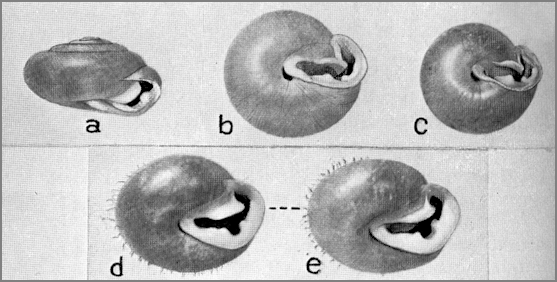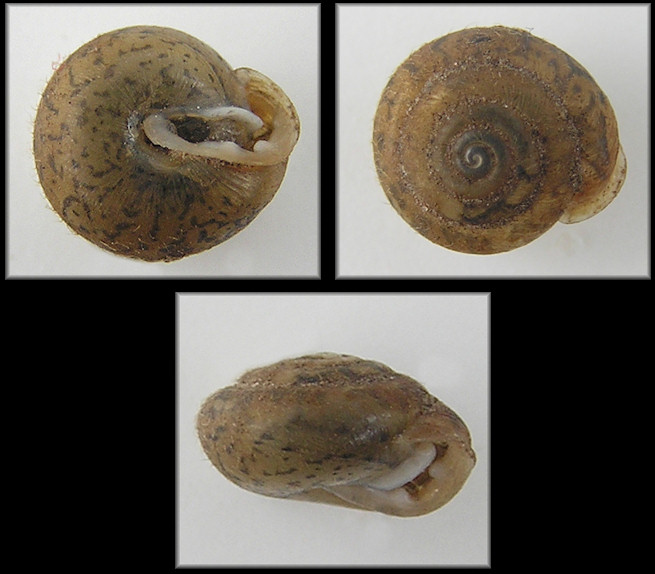|
Helix leporina: a Daedalochila or a Lobosculum?
by Harry G. Lee
Recently I caught myself making an egregious misidentification on a smallish land snail taken from a leaf litter sample harvested by Henry McCullagh in eastern Arkansas. I had diagnosed "Inflectarius inflectus (Say, 1821) with a conspicuous buttress like a Stenotrema." It took a couple of weeks to sink in that the shell was actually that of Lobosculum leporinum (Gould, 1848: 39) Gulf Coast Liptooth. Here are the original description and
the first illustration (Binney, 1857: plate 40a, figs. 1; see image
below, left). Interestingly, Gould considered this species "intermediate between" H. hirsuta Say, 1817, which has a buttress; see The Genus Stenotrema Rafinesque, 1815 (as Stenotrema; this shell feature demonstrated in fig. D1, image below right, upper arrow) and H. inflecta (my misidentification; see Inflectarius inflectus (Say, 1821) Shagreen as Inflectarius).
|

Binney, 1857: plate 40a, figs.1
|
 |
The unraveling of this confusion exposes us to some unusual
nomenclatorial and taxonomic situations. Our topical shell clearly has
close affinities with Lobosculum [TS Helix pustula
Férussac, 1832 SD Pilsbry, 1930: 319; see Lobosculum pustula (Férussac, 1832) Grooved Liptooth. Nonetheless, based on its lack of a penial appendage, Emberton (1995) was the first to transfer this species to Daedalochila Beck (1837: 21) [TS Polygyra auriculata Say, 1818: 277-278 SD Herrmannsen (1847: 369;], an interesting placement on conchological grounds as the labral lamella lacks the exclusive generic character, the "uvula" of Shuttleworth; see Daedalochila uvulifera (Shuttleworth, 1852) Peninsula Liptooth. Pilsbry (1940: 607) was aware of the genital deficiency in this species but
considered the
(absent) feature
to be a convergent character and grouped the Férussac taxon with Lobosculum rather than Daedalochila.
Emberton was dedicated to an unbiased cladistic approach and apparently
wasn't able to factor in Pilsbry's hypothesis.
Getting a handle on the type species of Lobosculum requires an
immersion in one of the more Byzantine Nineteenth Century conchological
works, that of Andre Étienne Just Pascal Joseph François d’Audebard,
Baron de Férussac, to whom this species, Helix pustula, is
attributed. The description consists of (1) the figures (Férussac, 1822:
plate 50, figs. 1; vidi, but subsequently removed from on-line
access) and (2) the plate explanation (Férussac, 1832 Tome 1:
78), neither by itself constituting a nomenclatorial action. Many
authors, e.g., Pilsbry (loc. cit.) mistakenly concluded
that the two publications were concurrent and cited 1822 as the date of
description for this and many other taxa actually not made available
until later publication by the author. Not affecting our species, but
impacting lots of others is a similar misunderstanding of the Baron's
convoluted work: many of the new taxa he proposed in a related work the
preceding year (Férussac, 1821) were incorrectly characterized by
Sherborn (1922-1932) as "n[omina]. n[uda]." Sherborn overlooked the fact
that most of them were made available when the companion plates, along
with those of work involving H. pustula, appeared a decade later.
Most of the blame for these misinterpretations of the context (Férussac
and Deshayes, 1819-1851) can be attributed to the rarity of the work and
chronology of its publication (vide infra for discussion and
collation). That detraction is greatly offset by the generally very
well-executed figures, far above the standard of the day. Unfortunately,
as with many of the smaller species, those of H. pustula are not
of the exquisite caliber of the majority, yet the similarity between
H. pustula Férussac and H. leporina Gould is quite evident.
Back to the Twentieth Century
.... the vernacular name provided by
Fred Thompson (in Turgeon, Quinn, et al., 1998), may prove less
mutable than its scientific counterpart. I ask the reader to determine
its proper generic placement based on the evidence presented here;
it appears that my hasty nomination of Inflectarius should be
withdrawn from the slate of contenders.
|
 |
|
(a) Indiana |
(b) Arkansas, from Bland |
(c) Cedar Point, Mobile Bay |
(d, e) Frierson, LA |
|
Pilsbry, 1940: page
612 , fig. 391
|
Literature cited:
Beck, H., 1837-1838. Index Molluscorum praesentis aevis Musei Principis Augustissimi Christiani Frederici. Copenhagen. [1837: pp. 1-100; 1838: pp. 101-124; 1-8].
Binney, A. [ed. A.A. Gould], 1857. The terrestrial air-breathing mollusks of the United States and the adjacent territories of North America. vol. 3. Little Brown, Boston. pp. 6-40 + 84 pls. [1-74 +10 bis; recto: majority hand-colored; verso: uncolored duplicates of recto, except pl. 71 verso only; total 167; several artists and engravers].
Emberton, K.C., 1995. "When shells do not tell: 145 million years of evolution in North America’s Polygyrid land snails, with a revision and conservation priorities". Malacologia 37: 69-110.
Férussac [A.E.J.P.J.F. d’A.], Baron de, 1821. Tableaux systématiques des animaux mollusques classés en familles naturelles, dans lesquels on a établi la concordance de tous les systèmes; suivis d’un prodrome général pour tous les mollusques terrestres ou fluviatiles,
vivants ou fossils. [Premiere Partie Tableaux systématiques généraux de
l’embranchemant divisés en familles naturelles] Deuxième partie
(premiere section.). Tableaux particuliers des mollusques terrestres et
fluviatiles, présentant pour chaque famille les genres et espèces qui la composent. Bertrand, Paris. [i]-xlvii + [i] + [3]-27 + [3]-110 + [i].
This monograph forms a part of the author's larger work, Férussac and
Deshayes, 1819-1851; vide infra.
¹ ² Férussac, A.E.J.P.J.F. d’A. de and G.-P. Deshayes, 1819-1851. Histoire naturelle générale et particulière des mollusques terrestres et fluviatiles, tant des espèces que l'on trouve aujourd'hui vivantes, que des dépouilles fossiles de celles qui n'existent plus; classés d'après les caractères essentiels que présentent ces animaux et leurs coquilles. J.-B. Bailliere, Paris. Tome 1: 8 + 184 pp [not seen]; Tome 2 (1): 402 p.; Tome 2 (2): 260 + 22 + 16 pp; ³ Atlas 1 (Tome 3): pls. 1- 70; º Atlas 2 (Tome 4): pls. 71-166 + pls. 1-5.
Gould, A.A., 1848. Untitled ["Shells collected by Mr. J. Bartlett,
in the south-western States, for the late Dr. Binney ..."].
Proceedings of the Boston Society of Natural History 3: 37-41.
Herrmannsen, A.N., 1846-1847. Indicis Generum Malacozoorum Primordia, Nomina subgenerum, generum .... vol. 1. Theodor Fischer, Cassell. pp. i-xxvii + 1-637. Sept. 1-July 17 (in 6 parts)
Pilsbry, H.A., 1930. "Anatomy and relationships of some American Helicidae and Polygyridae". Proceedings of the Academy of Natural Sciences of Philadelphia 82: 303-327 [not seen]
Pilsbry, H.A., 1940. Land Mollusca of North America (north of
Mexico) vol. 1 part 2. Academy of Natural Sciences, Philadelphia. v + 575-994 + ix. 1 Aug.
Say, T., 1818. "Account of two new genera and several new species,
of fresh water and land shells". Journal of the Academy of Natural Sciences of Philadelphia 1(2): 276-284. July.
Sherborn, C.D., 1922-32. Index animalium sive index nominum quae ab A. D. MDCCLVIII generibus et speciebus animalium imposita sunt. Sectio secunda. A Kalendis Ianuariis, MDCCCI usque ad finem Decembris, MDCCCL. Longsmans, Green, & Co. and British Museum (Natural History), London. cxxxi + 7,056 pp.
Turgeon, D.D., J.F. Quinn, Jr., A.E. Bogan,
E.V. Coan, F.G. Hochberg, W.G. Lyons, P.M. Mikkelsen, R.J. Neves, C.F.E. Roper, G. Rosenberg, B. Roth, A. Scheltema, F.G. Thompson, M. Vecchione, and J.D. Williams, 1998. "Common and scientific names of aquatic invertebrates from the United States and Canada: mollusks, 2nd edition". American Fisheries Society, Special
Publication 26, Bethesda, Maryland. ix + pp. 1-509 + 16 pls. (unpaginated).
Footnotes:
¹ This work appeared in many livraisons/Lieferungen. In the period 1819-1832, 28 livraisons appeared, consisting of texts and plates, not necessarily connected with each other. Many plate numbers appeared twice. Covers usually had no important texts or names printed on them. Explanations of plates 1-47 were published in livraison 9 (6 Apr., 1821), explanation of included plates on the cover in livraison 17 (2 Nov., 1822), explanation of plates on the cover of livraisons 22-27 (4 Aug., 1832 - serious error in Bouchet & Rocroi 2005: 305: "4 August 1823" is a misprint for "4 August 1832") (species were printed in small caps in these lists, with references to corresponding numbers in Prodr. [italics]). When the whole work was finished, a final issue of plate explanations appeared (1851, species names were in normal and bold font, authors not bold, no references to Prodr.). Usually only the final plate explanations were bound, while the initial plate explanations, different from the final ones, were not conserved by librarians.
Title, préface pp (i)-xvi (6 Mar., 1819)
pp 1-16 (5 Jun., 1819)
pp 17-56 (10 Jul., 1819)
pp 57-72 (18 Sep., 1819)
pp 73-96 (4 Dec., 1819)
pp 97-128 (17 Jun., 1820)
explanation of plates 1-47 (6 Apr 1821)
explanation of plates 48, 53, 63, 75A, 75B, 113 (2 Nov., 1822)
pp 96a-96[lambda] (27 Sep., 1823)
explanation of plates of livraisons 22-27 (many plates, 4 Aug. 1832)
explanation of plates 8E, 126, 131B, 133, 141, 147 (4 Aug., 1832 ?)
(cover not conserved in London but should have existed)
Plates (uncaptioned): 1, 2, 4, 8, 12 (6 Mar., 1819); 3, 5-7, 11, 13 (5
Jun., 1819); 9, 15-17, 19, 23 (18 Sept., 1819); 14, 18, 20, 22, 24, 25
(4 Dec., 1819); 21, 21A, 26-28, 30 (26 Feb., 1820); 29, 30-34, 57 (17
June, 1820); 52, 75, "66"[=76], 91, 92, 103 (5 Aug., 1820); 8A, 39A, 54,
73, 112, 120 (6 Apr., 1821); 32B, "101"[=51B], 63A,114, 115, 159 (26
May, 1821); 11A, 21B, 32A, 35, 39, 44 (13 July, 1821); 36, 38, 46, 81,
108, 118 (21 Sept., 1821); 9A, 37, 40, 41, 43, 62 (10 Nov., 1821); the
others by Férussac in 1822 and 1823..
Plates issued by Deshayes:
pl. 8F, 10A, 17A, 28A, 29A, 69C, 73B, 83, 84, 106, 107, 129 (1839)
pl. 10B, 62A, 69B, 69D-69H, 69K, 72, 85, 86 (1840)
pl. 37A, 55 [4], 62B, 64A, 69I, 69J, 75C, 87, 89 [2], 90 [3], 127A, 127B
(1841).
The above collation is based on Bouchet and Rocroi (2005: 304), Kennard (1942:1-4), and Gittenberger and Groh (1986) and is posted at Reference summary for Férussac, A. E. J. P. J. F. d'Audebard de & Deshayes, G.-P. 1819-1851
²
There is a curious text version of the above work at Google Books. It has an 1819 title page and is comprised of "Tome I" [? Tome 2 (2)] beginning with a préface [pp (i)-xvi] followed by (1)-184, but having are many, many pages no. 96 (various sub-pagination indicators, e.g. 96a, 96b, etc.) and "Tome II" [? Tome 2 (2)], which runs from (1) to p. 260.
³ Atlas 1 (Tome 3) with plates 1-69K (69, 69A, etc. yielding 12 pl. 69's and lots of other A's and B's; plate 70 missing, perhaps missed in the scanning process) is posted at Google Books.
º Atlas 2 (Tome 4) is posted at Google Books and contains plates 71 to 166 [with multiple A's and B's] + fossil
plates 1 to 5 + (1)-22 [explication des planches; cross-referenced to
indicate that there are 247 plates in toto] + ii, unpaginated [errata
and addenda].
An emended version of the Férussac masterwork collation can be found on pp. 2-4 of the Shell-O-Gram, July-August 2018.
|



